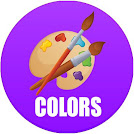
Learning colors in Spanish | What are the basic colors in Spanish?
Start learning colors in Spanish. It is easy.
The colors have a lot of importance, for example, the color of our hair and dressing can make a big difference to our appearance. The color gray is one of the oldest known colors in human history.
There are many colors and they are so useful that you can describe anything with them and that is why it is very important to know how to pronounce and learning colors in Spanish.
List of colors
gray = gris
orange = anaranjado
red = rojo
yellow= amarillo
purple = morado, violeta
blue = azul
green = verde
white = blanco
black= negro
brown = marrón, carmelita
Now it is time to show you the list of more than 10 colors and their pronunciations.
The Colors (Los Colores)
Learn more about the colors in Spanish
Amarillo (Yellow)

Anaranjado(Orange)

Verde (Green)

Rosado (Pink)

Morado (Purple)

Marrón (Brown)

Azul (Blue)

Gris (Gray)

Rojo (Red)

Negro (Black)

Blanco (White)
Surely you have asked: How do you say colors?
If you decide to learn this language the colors are one of the basic topics that you should know. You should be ready when they ask you something like: what are the seven colors in Spanish or simply ask you to describe an object.
The colors is translated as *los colores* and they can be categorized into three main types.
Types of Colors
– Primary Colors: There are three colors in Spanish: red = rojo, blue = azul, and yellow = amarillo
– Secondary Colors: There are three colors in Spanish: orange = anaranjado, green = verde, violet = violeta
– Tertiary Colors: The combination of primary with the secondary: Red-Orange, Yellow-Orange, Yellow-Green, Blue-Green, Blue-Violet, Red-Violet.
Nowadays cool colors are used a lot.
Although it may be difficult for many beginners to comprehend all these details of basic Spanish, with enough practice, anyone can learn how to speak and write Spanish. If you’re looking to improve your Spanish vocabulary, try learning Spanish words. Try using Spanish words in sentences that make sense to you, so you’ll get better at recognizing the difference between the two languages. Remember that every language has its unique vocabulary and rules. With enough practice, you’ll soon be able to understand and speak almost any kind of sentence in any type of language.
Now it is time for you to go and practice the colors with your friends and family.
In conclusion, we learned that Spanish nouns come in many colors. Flowers, animals, and people all have their favorite colors or shades. Now you should try it!


